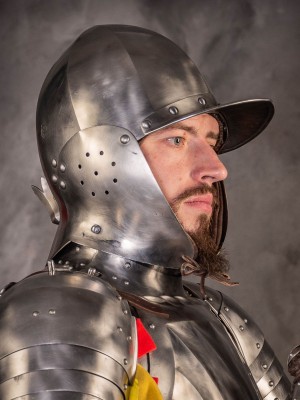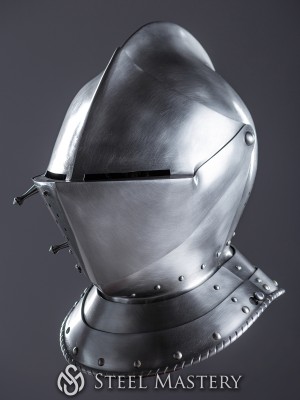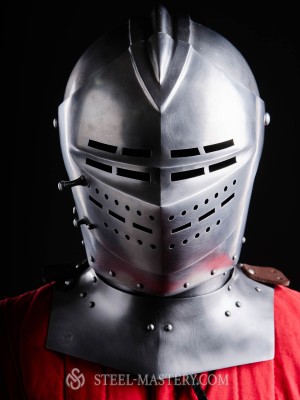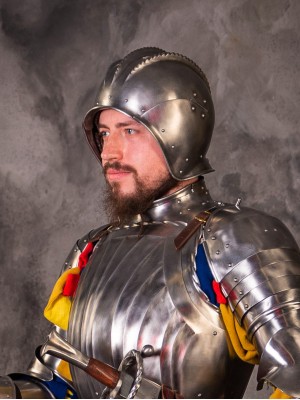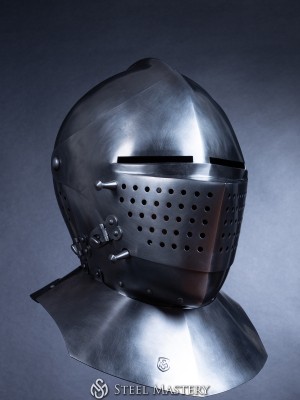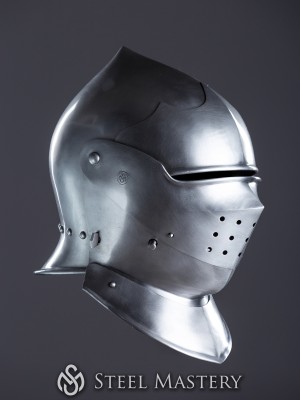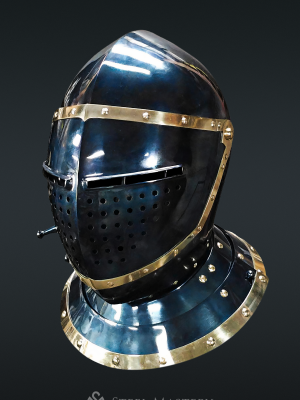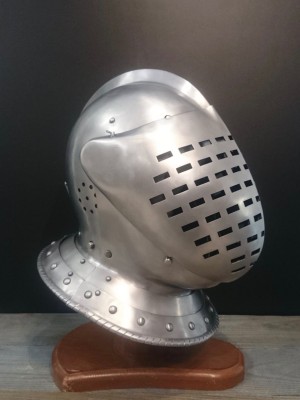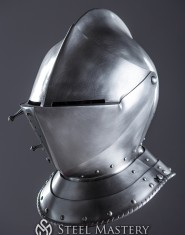About Closed face (armet) helmets
There are few "armet shticks" to distinguish it from others:
- Spherical dome.
- Chin made of two drop-down cheekpieces connected by pin in closed position.
- Second visor, reclining on the back of one’s head.
- Helmet fits owner’s head and neck really tight, it’s compact and light enough to be carried by owner.
- Helmet’s weight doesn’t press onto one’s head as it is apportioned on shoulders.
Early armet
Early medieval armet evolved from bascinet at the turn of XIV-XVth in Italy as Milanese armor component. It still had spheroconical dome, however, it was much rounder than bascinets. From the very beginning its features were: sewn-in cap, tight fit, chin made of two opening halves. Early armet also had second visor that reclined on the back of one’s head (however, there were versions without an upper visor, when halves of lower visor were stretched forward like the Hounskull's). Nonetheless, they still used an aventail as neck protection.
You can see various models in Churburg castle collection.
Classic armet
In the middle of XVth century, classical Italian armet appeared, subsequently becoming popular widely outside Italy. You can recognise it by:
- sparrow's-beak visor,
- rondel on the occipital part,
- gorget rather than aventail,
- completely spherical dome (some domes were forged from two halves that were welded together so that junction formed a small ridge, which served as an additional stiffener),
- narrow breathing slots rather than round holes.
Towards the XV century’s end armet with lower visor appears – forged in solid chin form, fixed on a loop on helmet’s left side while fastened with latch on the right. You can see it in Eugène Emmanuel Viollet-le-Duc works.
Late XVth century armet’s visor became longer with completely covered chin in front. It actually became popular in XVIth century tournament.
Maximilian armet
Corrugated armor, introduced by Emperor Maximilian I in XVIth century, starts as a synthesis of Gothic and Milanese armors. Surely, corrugated armor needed its own helmet. And got it – Maximilian Armet – popular during first third of XVIth together with accordant armor.
Its dome had corrugation together with low ridge form stiffener.
You can also recognise it by specific visor forms:
- "Bellows-visor" – ribbed visor with horizontal edges and crevices.
- "Sparrow beak" – classic pointed-nosed visor, widespread during XV-XVI centuries.
- Classic single visor.
- Double visor that appeared during 20s of the XVIth. "Beak" is divided into upper and lower visors, so that upper visor can be folded up – "open the beak" – to improve visibility when lower visor is lowered.
- "Monkey face"/"pug-nose" had protruding part with wide vertical grille-like slots below visual slits.
- "Grotesque" – human face or animal muzzle mask as a visor.
Face’s lower part protection could have few variants:
- lower & upper visors reclining upwards, often both mounted on same hinge;
- lower visor was not mounted on a hinge but simply fastened in front;
- lower visor just like early or classic armets had.
Gorget could also have few variants:
- traditional combination of gorget lames, protecting fighter’s throat with bevor;
- "burgundian gorget" – flexible construction, consisting of plate rings capable of tilting in any direction.
XVIth century armet
After the first third of XVIth Maximilian armor's fashion departed while smooth Milan-type armor became popular again.
We can divide XVI century helmets into three directions of Milan armet evolution:
- Battle armets with improved visibility and convenience for battles. Their upper visor covered entire chin thereby providing good overview even without lifting it due to horizontally located viewing slots.
- "Frog-mouth helm" – part of reinforced half-armor for tournament equestrian fights. Such armet was a part of an armor set but intended exclusively for tournaments use – like Stechhelm from The Metropolitan Museum.
- Tournament armet for foot combat. During late medieval tournaments, fights on blunt tournament swords and wooden maces took place so there was no need to protect against injections. However, maximum visibility and convenience was necessary. Considering this purpose, armets with visor in “grid of rods” form were made. These include tournament armet for foot combat from King René's Tournament Book and tournament armet from The Metropolitan Museum.
Armet remained popular as a tournament helmet till the death of King Henry II in 1559 when spear’s jab threw king’s visor away and spear piece mortally wounded him in the eye. It was an end of armets’ popularity in tournaments. Besides, on battlefields, they were supplanted by burgonets even earlier.
Yes, armet is one really serious helmet serious fighters should have. So if you choose it, then you should buy it from one serious manufacturer – Steel Mastery ;)
Our blacksmiths with experience of over 15 years will forge the best helmet for you. Additionally to impeccable quality, we offer adequate price and are ready to personalize any model just for you. After all, if Henry VIII could pamper himself with horned-one helmet then why can’t you? ;)
Besides, just look at these cool full plate armors with armets we can offer:
Milan-style full plate armour 1450-1485 years
All you need to have one is to place an order on our site using convenient system of options or write to us, if you have special wishes. We are waiting for your orders!

